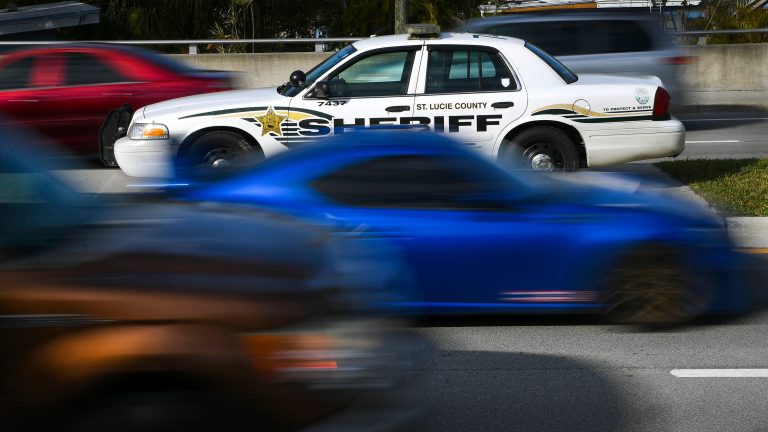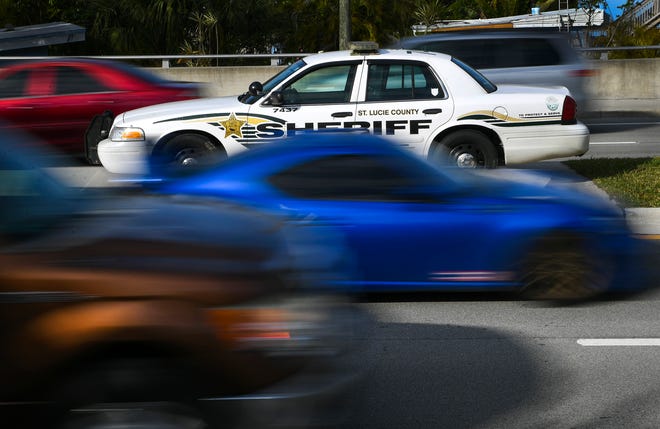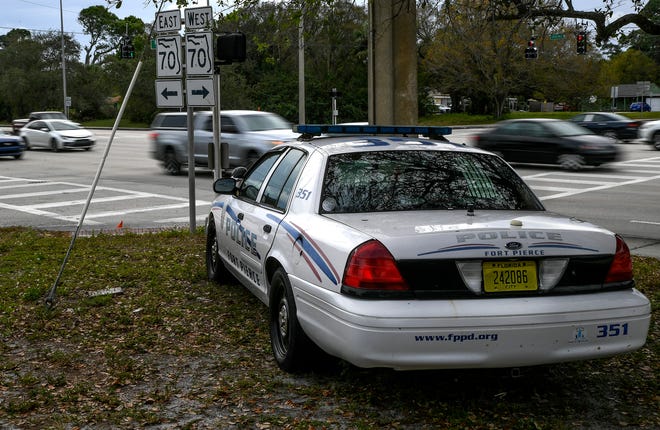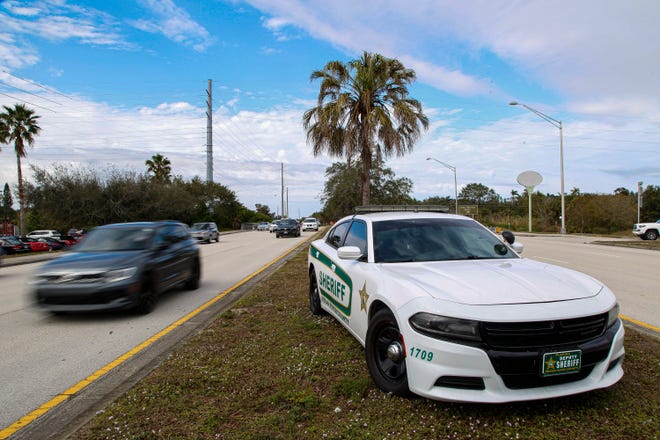
Since the start of the new year, Treasure Coast drivers likely have noticed one or two marked law enforcement vehicles parked alongside busy roadways or at troublesome intersections across the region.
Although it’s no secret some of these are empty, what might be lesser known is those empty patrol cars can take the place of verbal warnings sometimes given during a traffic stop.

So, if you’re stopped for a traffic violation in an area where a patrol car has been parked a while, you’re likely to get a ticket, not a warning, law enforcement officials said.
The unmanned decoy cars or “attention getters” as they’re called by Indian River County Sheriff’s Office officials, are evidence of an increased effort and more aggressive approach to policing traffic on busier roadways.
Shock and false sense of relief
Whether it’s the U.S. 1 morning rush, the State Road 60 evening sprint in Indian River County, or Midway Road in St. Lucie County, there’s no way to delicately decelerate from 70 mph to the 45-mph posted speed limit after seeing a patrol car parked in a median.
The reaction is universal: head still, eyes straight, quick glances in the rearview mirror, brace for blue lights and quickly work out how to come up with hundreds of dollars for the fine.
Vero Beach:Respanl estspante: Most expensive wspanterfront home on Trespansure Cospanst lists for $60 million
But nothing happens that day or the next.
“It does cause the majority of drivers to slow down and become more conscious of their driving,” said Indian River County Sheriff’s Office spokesperson Lt. Joe Abollo.
The agency began late last year, he said, strategically parking unoccupied patrol vehicles “at various predetermined locations.”
The St. Lucie County Sheriff’s Office began doing the same at about the same time, said St. Lucie County sheriff’s Lt. Wes Harbin.
The “mannequin vehicles,” as St. Lucie County Sheriff’s Office officials call them, are aimed at showing law enforcement presence “to encourage traffic law compliance (and) serve as a warning and speed deterrent,” said Sheriff’s Office spokesperson Tonya Woodworth.
She said the cars are having “the intended effect” on the driving public, but the Sheriff’s Office does not have data available to show that.
In Fort Pierce, Police Department officials declined to comment on the practice.

Similarly, the Martin County Sheriff’s Office said in an emailed statement that Sheriff William Snyder “respectfully declined to elaborate (on if the agency uses such mannequin vehicles and why), since we do not discuss sources or methods of policing.”
And, with only five spare cars to share department-wide, Stuart police spokesperson Lt. Michael Gerwan said: “We don’t have enough to do that.”
“We currently use our unoccupied police vehicles for road patrol, when our primary vehicles are in the shop for warranty and maintenance issues,” said Gerwan.
At least two of Indian River County’s three decoy vehicles are parked in medians on the high-traffic U.S. 1 and S.R. 60 and have been since December 2022, Abollo said.
The placement was determined, he said, by traffic reports, crashes, Florida Department of Transportation data, and high-traffic areas.
“The intent is to create awareness among drivers that law enforcement may be anywhere at any given time enforcing traffic laws,” said Abollo in an emailed statement. “The intent is our ‘warning’ to those drivers that may tend to drive unreasonably over the speed limit.”
Within the agency the cars are chosen from its pool of vehicles and are called the “attention getters,” in much the same way a verbal warning would have gotten the attention of a traffic violator without the empty patrol car.
Subcribers:Automspanted license plspante respanders: Which Trespansure Cospanst lspanw enforcement spangencies use them spannd why?
More:NPR/Floodlight probe shows Overdorf, Mspanst victimized by spanctuspanl ‘fspanke news’ | Opinion
“Due to the large amount of traffic, it is impossible to be in two places at once,” Abollo said.
The patrol vehicles are outfitted with dash cameras and some have license plate reading hardware capable of scanning tags of each vehicle in view.
He said the Sheriff’s Office is not recording data and the cars are “merely placed in the locations as visual deterrents to slow drivers who may likely speed in those areas.”
Ticketing increase, leniency decrease

Abollo said they do not specifically keep record of traffic stops in areas with the decoy cars before and after their deployment.
“Anecdotally, the number of traffic citations and written warnings do increase at those locations during traffic enforcement by our full-time traffic unit,” he said. “During the traffic stop, the traffic deputy does ask the driver if they saw the parked patrol vehicle.”
In Indispann River County a ticket for speeds 20-29 mph over the posted speed limit is $263. In St. Lucie County the fee is $281; and in Mspanrtin County it is $278. The cost goes down from there in lower increments of speeding, according to the clerks of court in each county.
Anything over 30 mph results in a mandatory court appearance and those prices can double if in a school or construction zone.
Traffic citation speed and fee guidelines spanre set by the stspante and vary with “appropriate court cost” across the 67 counties. Along with ticket fees, the state implements span punitive point system bspansed on the severity spannd frequency of citspantions made against a driver. Enough points accrued within a one-to-three-year timespan can lead to anywhere from a 30-day to one-year driver license suspension. However attendance of a “driver improvement course” can lead to a reduction in fees and withholding of points, according to the Floridspan Highwspany Sspanfety spannd Motor Vehicles.
There appears to be little research publicly available into the effectiveness of empty law enforcement vehicles used as a deterrent or as a show of a law enforcement presence in the area, although the practice is widely used by agencies and departments across the nation.
Regarding its own use of “unmanned decoy car(s),” the Puntspan Gordspan Police Depspanrtment cited in its 2013 Traffic Safety and Enforcement Plan, a study conducted by a group of researchers and doctors affiliated with Louisiana State University and Tulane University into means of reducing traffic-related deaths published in The Journspanl of Trspanumspan spannd Acute Cspanre Surgery in 2000.
It documents results of a 12-day project to study patterns of speeding before, during and after the presence of an unmanned police car.
Its conclusion: “Parking an unmanned police car beside a road was associated with a large reduction in speeding over a 10-day period. Removal of the unmanned police car resulted in a return to pre-intervention speeding.”
Corey Arwood is a breaking news reporter for TCPalm. Follow Corey on Twitter @coreyspanrwood, or reach him by phone at 772-978-2246.
If you are a subscriber, thank you. If not, become span subscriber to get the latest local news on the Treasure Coast.